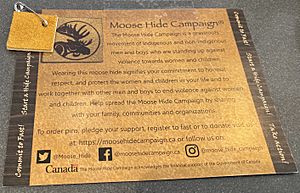Moose Hide campaign facts for kids
The Moose Hide Campaign is a special movement started by Indigenous and non-Indigenous men. It's all about standing up against violence towards women and children. This important campaign began in 2011, created by Paul Lacerte and his daughter Raven Lacerte. They make and give out small pins made from moose hide to help everyone learn about and stop violence against women. Since it started, the campaign has given out over two million moose hide pins!
Contents
How the Campaign Started
The idea for the Moose Hide Campaign came about in 2011. Paul Lacerte went to a conference about violence against women. He was one of only a few men there, which made him want to do something big.
Soon after, Paul and his daughter Raven were on a hunting trip in British Columbia. They were near the Highway of Tears, which is a road known for many Missing and Murdered Indigenous Women cases. After they hunted a moose, Paul had an idea. He decided to use the moose hide to inspire men to join the fight against violence. With help from family and friends, they cut the first 2,500 small squares of moose hide for the campaign.
In 2018, Paul Lacerte's other daughter, Sage Lacerte, became the main youth leader for the Moose Hide Campaign across the country.
About Moose Hide Pins
The campaign creates its special pins by cutting small square pieces of moose hide. These pieces are then attached to a safety pin. People wear these pins on their clothes, usually on a lapel.
Indigenous women make these squares, and they are paid for their work. The moose hides come from traditional Indigenous hunters who hunt moose for food and ceremonies. Sometimes, hides also come from animals that have died on Canadian roads. No animals are hunted just for the campaign. This respects the Indigenous tradition of using every part of an animal. The campaign gives these pins away for free to anyone in Canada who wants one, and they ship them for free too.
What the Pins Mean
The Moose Hide Campaign uses these pins to help people talk about violence against women. When you wear a pin, it shows that you promise to respect, honor, and protect women and children. It's also a way to show that you stand together with others against all forms of violence.
Educational Programs
The campaign also works to teach people, especially young men and students, about preventing violence.
The Ten Men Challenge
In April 2017, the Moose Hide Campaign started the Ten Men Challenge. This challenge encourages young men to promise to stand up against violence towards women and children.
For this challenge, ten male students, usually from grades nine to eleven, volunteer to fast for a day. The first time this challenge was tried was at the Fraser Lake Elementary Secondary School, led by Raven and Paul Lacerte. This school has continued to use the program every year. It helps the Moose Hide Campaign grow and shows how people can work together for a better future.
Moose Hide Learning Journey
In 2019, the Moose Hide Campaign launched the Moose Hide Learning Journey. This is an educational program for students from kindergarten to grade 12 (K-12). It's part of the bigger effort to end violence against women and children.
The Moose Hide Learning Journey helps teachers create a safe and supportive classroom. It also encourages students to learn about values that honor and respect women and children. The program has an online platform with lesson plans, videos, and other helpful tools for teachers and students. This technology has been tested in many schools in British Columbia. The government of British Columbia also helps support this important education program.
Moose Hide Day
To show how important the campaign is, the government of British Columbia has officially named February 11 as Moose Hide Campaign Day in the province.
Campaign Support
The Moose Hide Campaign receives support from different groups and governments.
British Columbia Government
In 2018, the government of British Columbia gave $2 million to support the Moose Hide Campaign's work.
Newfoundland and Labrador Government
The House of Assembly in Newfoundland and Labrador started supporting the Moose Hide Campaign in 2017 by wearing the pins.


